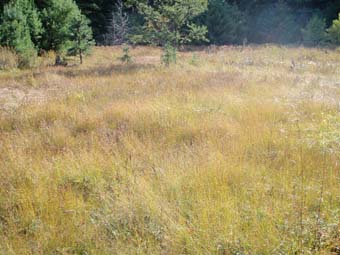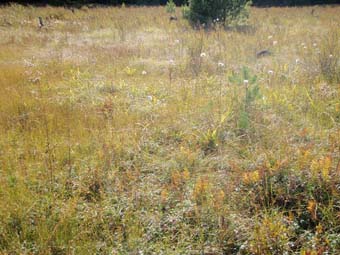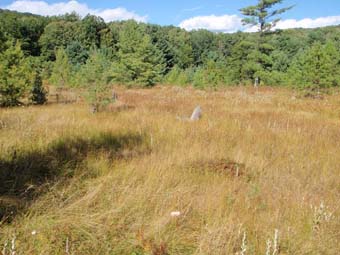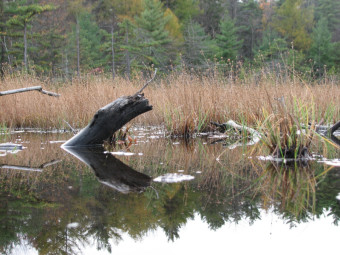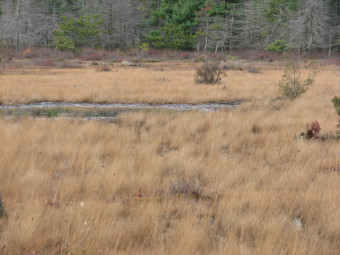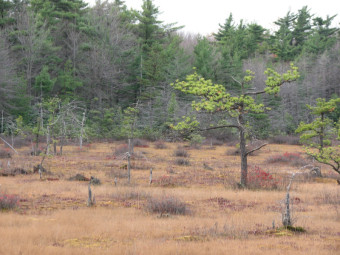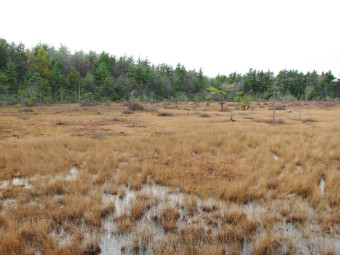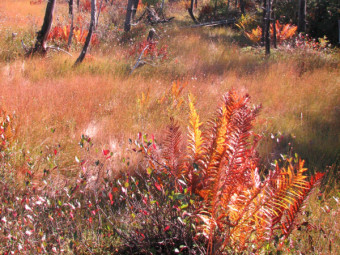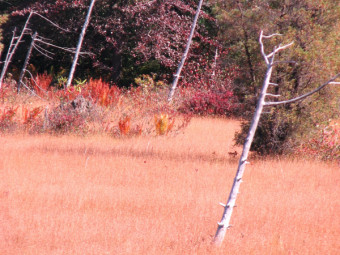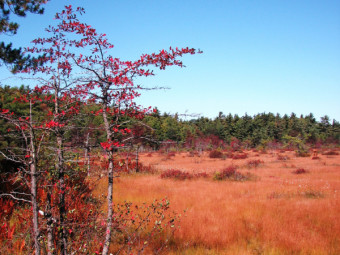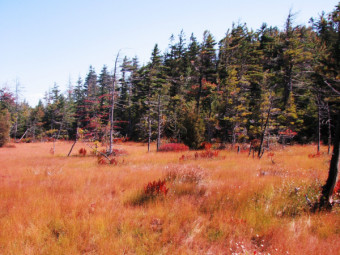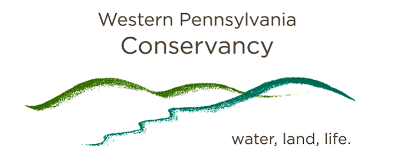Sphagnum – Beak-rush Peatland
System: Palustrine
Subsystem: Herbaceous
PA Ecological Group(s): Peatland Wetland
Global Rank:GNR
![]() rank interpretation
rank interpretation
State Rank: S3
General Description
This type occurs in the open areas of many acidic peatlands. The substrate is sphagnum peat, often a floating mat. Typical species include white beak-rush (Rhynchospora alba), pitcher-plant (Sarracenia purpurea), spatulate-leaved sundew (Drosera intermedia), round-leaved sundew (Drosera rotundifolia), yellow-eyed-grass (Xyris montana), brown-fruited rush (Juncus pelocarpus), sedge (Carex trisperma), white fringed-orchid (Platanthera blephariglottis), horned bladderwort (Utricularia cornuta), cotton-grass (Eriophorum vaginatum), and tawny cotton-grass (Eriophorum virginicum). Cranberry (Vaccinium macrocarpon), and small cranberry (Vaccinium oxycoccos) are abundant in some areas. Shrubs, such as leatherleaf (Chamaedaphne calyculata var. angustifolia), bog laurel (Kalmia polifolia), and bog-rosemary (Andromeda polifolia var. glaucophylla), may also occur but do not dominate the community. This community usually occupies one of the interior zones of a larger peatland complex that may also include shrub, woodland, and forest physiognomies.
Rank Justification
Vulnerable in the nation or state due to a restricted range, relatively few populations (often 80 or fewer), recent and widespread declines, or other factors making it vulnerable to extirpation.
Identification
- Thick sphagnum moss layer (Sphagnum spp.)
- Herbaceous layer dominated by white beak-rush (Rhynchospora alba) with tawny cotton-grass (Eriophorum virginicum), cranberry (Vaccinium macrocarpon), and small cranberry (Vaccinium oxycoccos) as co-dominate species
- Substrate is peat, often a floating mat
- Open canopy
Shrubs
Herbs
- White beak-rush (Rhynchospora alba)
- Pitcher-plant (Sarracenia purpurea)
- Spatulate-leaved sundew (Drosera intermedia)
- Round-leaved sundew (Drosera rotundifolia)
- Yellow-eyed-grass (Xyris montana)
- Brown-fruited rush (Juncus pelocarpus)
- Sedge (Carex trisperma)
- White fringed-orchid (Platanthera blephariglottis)
- Horned bladderwort (Utricularia cornuta)
- Cotton-grass (Eriophorum vaginatum)
- Tawny cotton-grass (Eriophorum virginicum)
Bryophytes
* limited to sites with higher soil calcium
Vascular plant nomenclature follows Rhoads and Block (2007). Bryophyte nomenclature follows Crum and Anderson (1981).
International Vegetation Classification Associations:
USNVC Crosswalk:None
Representative Community Types:
Oligotrophic Peatland Moss Lawn (CEGL006135)
NatureServe Ecological Systems:
Boreal-Laurentian Bog (CES103.581)
North-Central Interior and Appalachian Acidic Peatland (CES202.606)
NatureServe Group Level:
None
Origin of Concept
Fike, J. 1999. Terrestrial and palustrine plant communities of Pennsylvania. Pennsylvania Natural Diversity Inventory. Pennsylvania Department of Conservation and Recreation, Bureau of Forestry, Harrisburg, PA. 86 pp.
Pennsylvania Community Code*
HG : Sphagnum – Beaked Rush Peatland
*(DCNR 1999, Stone 2006)
Similar Ecological Communities
Many-Fruited Sedge – Bladderwort Poor Fen type has a very similar structure and setting, but occurs under the influence of groundwater that raises the pH to at least 5. There is a corresponding difference in species composition with the change in pH. Cotton-grass Poor Fen and Sphagnum – Beak-rush Peatland communities occur in glaciated and non-glaciated areas of Pennsylvania. Although sphagnum (Sphagnum spp.), tawny cotton-grass (Eriophorum virginicum), and beak-rush species (Rhynchospora spp.) are important in both types, the two communities differ in the overall species composition and in the environmental setting. The Cotton-grass Poor Fen is heavily dominated by tawny cotton-grass (Eriophorum virginicum) and rushes (Juncus spp.) while the Sphagnum – Beak-rush Peatland is dominated by white beak-rush (Rhynchospora alba). Degraded or modified Sphagnum – Beak-rush Peatlands may be very similar to Cotton-grass Poor Fen.
Fike Crosswalk
Sphagnum - Beak Rush Peatland
Conservation Value
Sphagnum – Beak-rush Peatland is rare in the state and rare plant species found in this community type may include yellow-eyed-grass (Xyris montana), horned bladderwort (Utricularia cornuta), mud sedge (Carex limosa), and bog-rosemary (Andromeda polifolia var. glaucophylla). This community also serves as a buffer for sediment and pollution runoff from adjacent developed lands by slowing the flow of surficial water causing sediment to settle within this wetland.
Threats
Alteration to the hydrological regime is a major threat to this community (e.g., impoundments, beaver dams) and can lead to habitat destruction and/or shifts in community function and dynamics. Clearing and development of adjacent land can lead to an accumulation of agricultural run-off and pollution, sedimentation, and insolation/thermal pollution. Invasive plant species such as cat-tails (Typha spp.) can dominate this community.
Management
A natural buffer around the wetland should be maintained in order to minimize nutrient runoff, pollution, and sedimentation. The potential for soil erosion based on soil texture, condition of the adjacent vegetation (mature forests vs. clearcuts), and the topography of the surrounding area (i.e., degree of slope) should be considered when establishing buffers. The buffer size should be increased if soils are erodible, adjacent vegetation has been logged, and the topography is steep as such factors could contribute to increased sedimentation and nutrient pollution. Direct impacts and habitat alteration should be avoided (e.g., roads, trails, filling of wetlands) and low impact alternatives (e.g., elevated footpaths, boardwalks, bridges) should be utilized in situations where accessing the wetland can not be avoided. Care should also be taken to control and prevent the spread of invasive species within the wetland.
Research Needs
Variations may occur at ecoregional levels. There is a need to collect plot data to characterize variations and guide further classification of this community.
Trends
Sphagnum – Beak-rush Peatlands were probably more common but declined due to wetland draining/filling and sedimentation. Wetland protection has most likely stabilized the decline of these communities. Degraded occurrences of this community may exist as the Cottongrass Fen Community.
Range Map
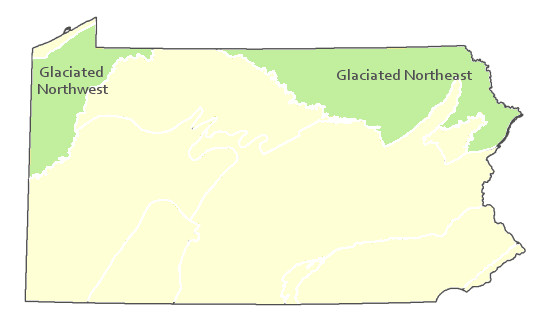
Pennsylvania Range
Glaciated NE and glaciated NW
Global Distribution
Connecticut, Massachusetts, Maine, New Hampshire, New York, Pennsylvania, and Vermont.
Fike, J. 1999. Terrestrial and palustrine plant communities of Pennsylvania. Pennsylvania Natural Diversity Inventory. Pennsylvania Department of Conservation and Recreation. Bureau of Forestry. Harrisburg, PA.
NatureServe 2010. NatureServe Explorer: An online encyclopedia of life Version 7.1. NatureServe, Arlington, VA. Available http://www.natureserv.org/explorer (accessed: 23 November 2011).
Pennsylvania Department of Conservation and Natural Resources (DCNR). 1999. Inventory Manual of Procedure. For the Fourth State Forest Management Plan. Pennsylvania Bureau of Forestry, Division of Forest Advisory Service. Harrisburg, PA. 51 ppg.
Rhoads, Ann F. and Timothy A. Block. 2002. Survey of Natural Areas of Hickory Run State Park. Report submitted to DCNR, Bureau of State Parks.
Rhoads, Ann F. and Timothy A. Block. 2006. Vegetation Inventory of Gouldsboro State Park. Report submitted to DCNR, Bureau of State Parks.
Stone, B., D. Gustafson, and B. Jones. 2006 (revised). Manual of Procedure for State Game Land Cover Typing. Commonwealth of Pennsylvania Game Commission, Bureau of Wildlife Habitat Management, Forest Inventory and Analysis Section, Forestry Division. Harrisburg, PA. 79 ppg.
Cite as:
Davis T. 2022. Pennsylvania Natural Heritage Program. Sphagnum – Beak-rush Peatland Factsheet. Available from: https://www.naturalheritage.state.pa.us/community.aspx?=16012 Date Accessed: July 27, 2024

